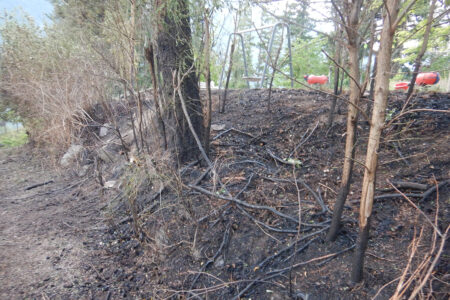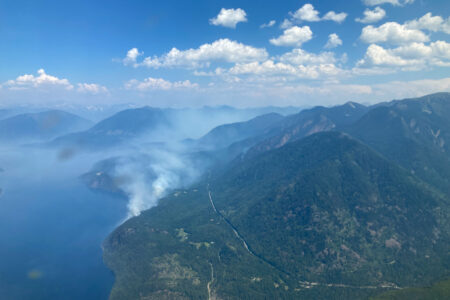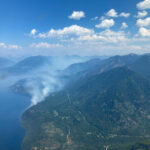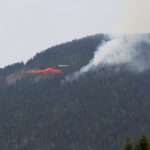The Battle for the Gilpin take two or twenty-two??
There is only one possible perfect solution in the battle over the Gilpin Grasslands for activist Barry Brandow – the removal of cattle from the park. But just dealing with the cattle is not going to be enough to protect the delicate grassland ecosystem, unique in the entire province of B.C. The park is also under threat from other recreation uses, and the deer populations seem to be declining. Brandow, a retired game hunter and teacher, hosted a meeting held at Selkirk College to once again put the problem of habitat degradation on the table. With an issue that has been through multiple planning processes since 1972, Brandow’s main goal of the meeting was to rally people for upcoming meetings to pursue regulatory changes for the park. For Brandow, a vision to protect the Gilpin grasslands which started with a small group of citizens in 1972, needs to be pursued. “That dream collapsed. I wanted to showcase (at the meeting) how that happened,” said Brandow. “A small number of bureaucrats destroyed it. So people now have a clear idea (about the history.) We have never had an opportunity to speak for wildlife or the land on that piece of ground. Until fish and wildlife staff chair the meetings and dictate what happens, we can’t go there. That’s why we want the wildlife management area. You can quit or you can strengthen your argument – that’s the only options you have. I’m not prepared to watch this thing go down the drain.” Foremost for Brandow are the years of consultations and discussions completed with provincial authorities that have yet to yield a result, and the distinct lack of administration by the provincial government for local parks. Along with the administrative gaps comes a lack of monitoring of the area, said Brandow. This point of view is supported by a report from the Auditor General’s office released last year delineating that while the vision for parks is good, “its plans were incomplete or dated; conservation policies are not being consistently upheld; and little action has been taken to ensure conservation.” (Conservation of Ecological Integrity in BC Parks 2010) The latest in the process was the development of a wildlife management area plan for the class A provincial park, the Gilpin Grasslands, created in 2007 but never implemented. In 2008, the draft plans for a wildlife management area (WMA) were posted for comment on the B.C. Parks website for about one year, explained Suntanu Dalal, public affairs officer for the Ministry of Environment. Dalal said that the primary objections to the WMA came from off-road vehicle users who felt there would be more restriction on access. “At this time there are other mechanisms the Ministry of Environment is currently engaged in to assist in maintaining and restoring important habitats in the general Crown land area,” said Dalal in an email. “The MOE has made significant headway in many projects in co-ordination with other agencies and stakeholders. There are no immediate plans to move the concept of a WMA forward at this time.” The park has significant grassland and wildlife values, including several provincially at risk arid grassland ecological communities containing numerous provincially red- and blue-listed plant and animal species. Approximately four kilometres of the park’s southern boundary includes riparian frontage along the Kettle River. (B.C. Parks Management Direction Statement 2009) “It’s an area that’s very strongly used for recreation,” said Rob Chorneki who attended the meeting. “Recreation now also includes motorbikes, SUV’s, ATV’s. This is one vulnerable area. When it comes to Gilpin we’re looking at habitat degradation. Most significant to wildlife throughout the province and Canada is habitat – the loss of habitat and lack of access to habitat. It’s a complex thing, its not just grass and water.” Cattle ranchers at the meeting commented on the issue of wildlife grazing on private land especially as winter range, which ranchers allow but could easily take action to prevent. The key ranch involved in the grazing of the Gilpin area is the Mehmal ranch, their rights dating back decades, but there are several on the edge of the park area. Brandow will be calling a meeting in the coming months to continue to pursue his vision for the protection of the grasslands. “(We need to at) least get enough public support to move this forward,” said Brandow. “One of our objectives is the equitable solution to the removal of cattle from class A parks. That is an initiative way above this valley. You can do many things to truth, but endlessly suppress it – never. I’m on that long journey.” Park information: According to the B.C. Parks web information, the park protects native grasslands essential to Bighorn Sheep, Rocky Mountain Elk, Mule Deer and Whitetail Deer along with other endangered, threatened or vulnerable species, some of which include:
- Red listed – Tiger Salamander, Western Screech Owl, Lewis’s Woodpecker, Badger, Great Basin Pocket Mouse and Speckled Dace fish;
- Blue listed – Western Rattlesnake, Gopher Snake, California Bighorn Sheep, Great Basin Spadefoot, Western Skink, Racer, Western Painted Turtle and Canyon Wren.























